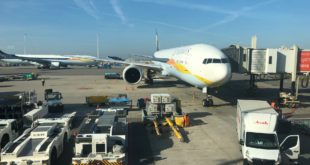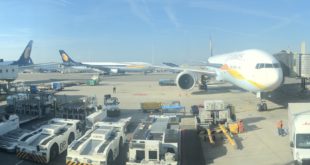Continuing the series of financial analyses of India’s airlines, today we take a look at Q1 for Jet Airways. JetLite will be covered in a separate post, as will overall analysis of the Indian market.
Previous Analyses: (Kingfisher, SpiceJet)
Surprisingly enough, Jet Airways, often considered the most stable of India’s 3 full service carriers, slid to a pretax loss of Rs. 1.57 billion in Q1 2012, down from a pretax profit of Rs. 35.4 million in the same period last year.
However, in spite of this disappointing result; Jet Airways’ absolute performance metrics did show some growth
- Revenue growth for Jet Airways was strong, with a 19.44% increase from Rs. 2965 Crore to Rs. 3541.6 Crore
- Passengers carried were up 14.6% to 4.07 million; almost perfectly matching demand growth for the overall industry.
- Passenger Yield was up 5.6% to Rs. 7,304
- Absolute non-fuel costs were up 16.0%, while absolute fuel costs jumped a staggering 57.00%; on a capacity increase of 14.1%, a 16.8% growth in number of flight hours flown, and a 20.2% increase in number of departures.
- Seat-kilometer revenues were up 4.9%, while seat-kilometer costs were up 14.4%; seat-kilometer costs excluding fuel were down 3.3%.
- Interest expenditures on debt were down 21.9% YOY to Rs. 214.23 Crore
- EBTIDA Profit (which measures operating results before taxes, interest, depreciation, and loan amortization) of Rs. 121.3 Crore, EBITDA loss of Rs. 6.5 Crore on Domestic, and EBITDA profit of Rs. 127.8 Crore
- International: R/ASK up 6.8%, C/ASK up 16.2%
- Domestic: R/ASK up 3.8%, C/ASK up 11.3%
Observations
Jet Airways is definitely the most financially stable of the Indian full-service airlines. However, with the largest overall network; they were also hurt the most by the jump in fuel prices. They showed strong discipline on non-fuel costs, and fleet utilization growth definitely helped that.
Of the 3 carrier’s study, Jet most closely matched capacity growth to demand growth. However, because they were growing off of a larger base; Jet’s ~16% jump in capacity led to a larger increase in total market capacity than SpiceJet’s 36.7% jump in capacity.
Domestically, they came under a lot of negative pricing pressure from India’s LCCs; and fares across this period did not increase at the natural rate (ie: with costs). However, remember that both JetKonnect and mainline Jet numbers are included in the domestic figures. I’d like to see a break-down of the numbers at the full-service wing; my guess is that with Kingfisher and Air India floundering a bit; the real revenue growth driver has been F-class fares and business traffic. But since Konnect now represents 75%! of Jet’s domestic capacity, the overall effect may have been muted.
It’s interesting to note the breakdown of revenues for Jet; 56.8% international, 41.2% domestic. With this revenue breakdown, the modest growth of international revenues was much more important to overall results than for Kingfisher or SpiceJet.
International RASK was up just 6.8% while Kingfisher’s grew at a 25% clip; did some of Kingfisher’s growth come at the expense of Jet?
Jet’s network is skewed more towards Mumbai than the other full service carriers. As IndiGo continues to expand at a fast clip; that likely affected domestic revenue. According to Jet, their presence at Terminal 3 (with its higher fuel costs) is a significant disadvantage in Delhi. Since JetLite is technically an LCC, I don’t think that it’s beyond Jet’s rights to ask for a shift of operations to Terminal 1D. Could that drive a diversification of the network to include more flights from Delhi?
Longer term, the challenges for Jet Airways are numerous. They need to find a way to re-integrate their 777s at some point, though at the moment the attractive lease rates for the popular 777-300ER make this slightly less of a problem. 2 aircraft returned from Turkish Airlines will be used to increase capacity on Mumbai-Hong Kong and Mumbai-Brussels-Newark in the coming months; but 5 aircraft remain leased out.
Jet will also have to deal with the madness that is sure to ensue as the government attempts to re-structure Air India. Many in the government are already speaking of things like giving Air India exclusive rights to international routes; and there may be some illogical capacity additions, and or fare-slashing from the folks in Delhi. But this problem is not unique to Jet Airways, and the carrier remains perhaps the best positioned (besides IndiGo) for long-term profitability.
-Vinay Bhaskara
Twitter: @TheABVinay
Contact me at vinay [at] bangaloreaviation [dot] com
Please feel free to comment on the post below
 Bangalore Aviation News, Reviews, Analysis and opinions of Indian Aviation
Bangalore Aviation News, Reviews, Analysis and opinions of Indian Aviation

